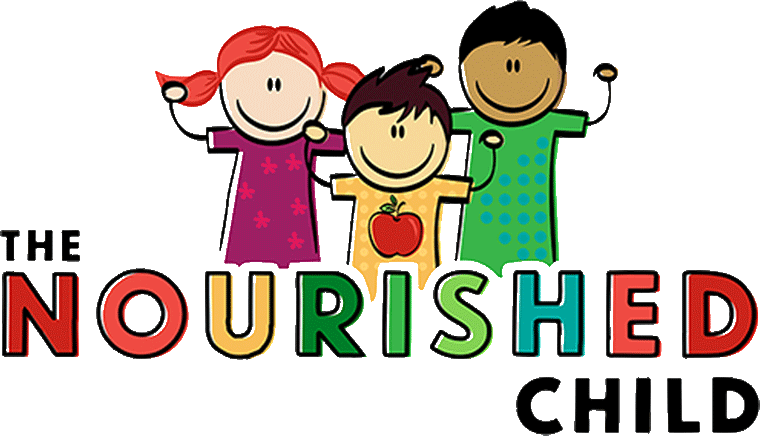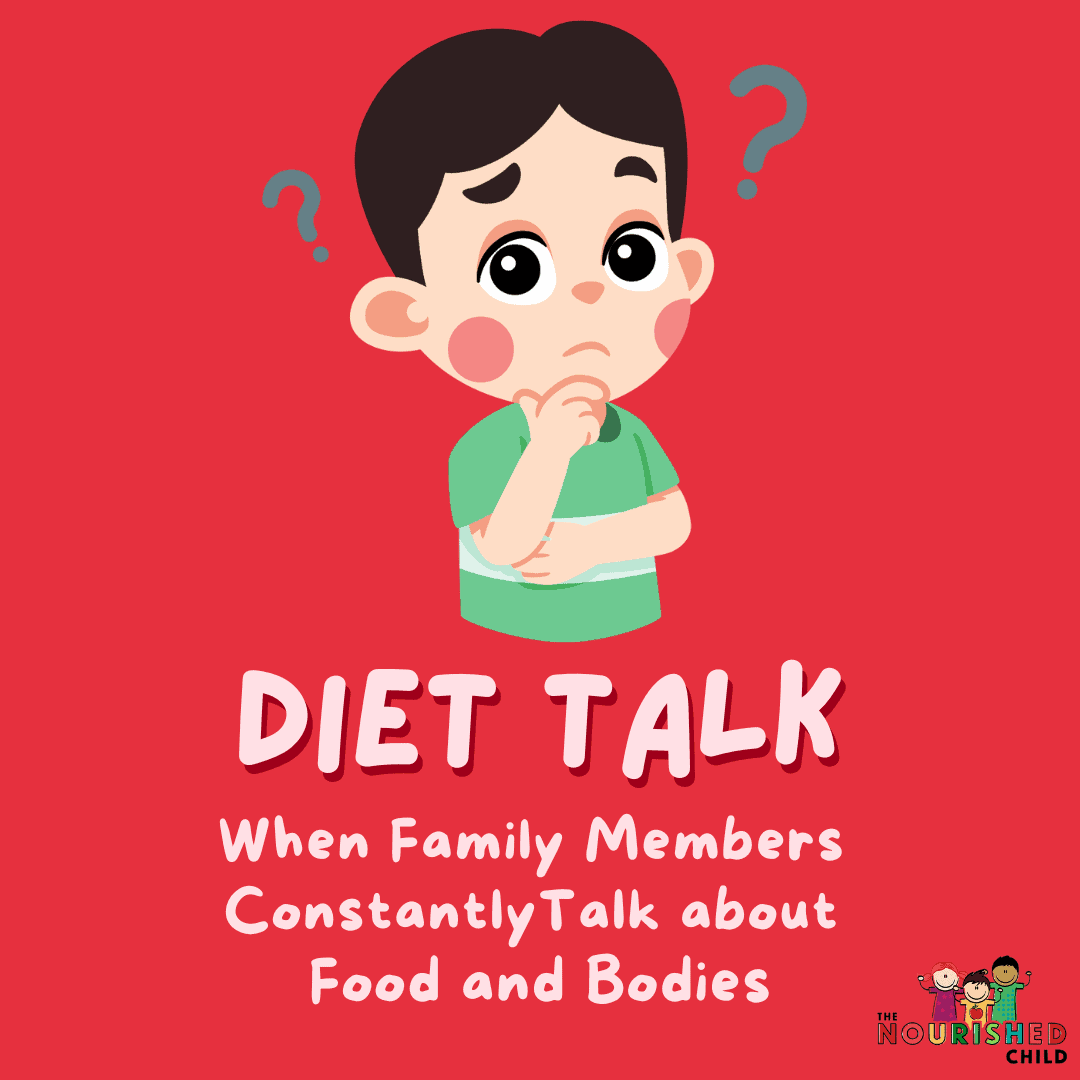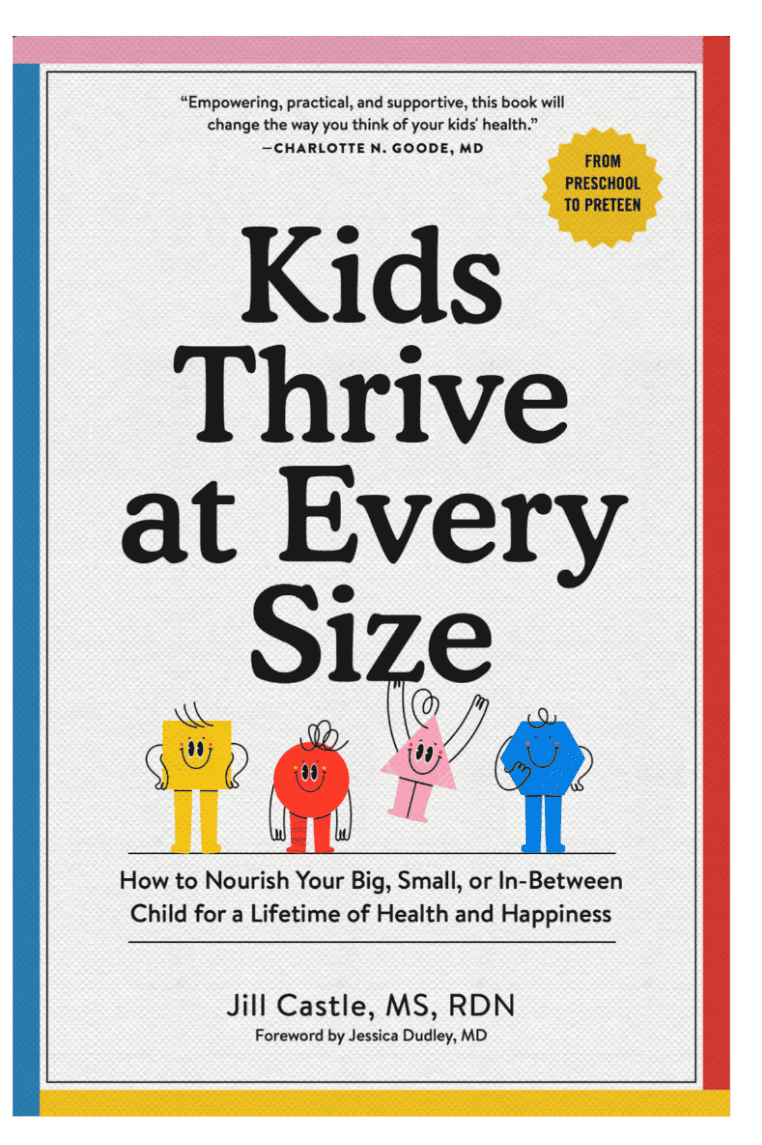Juice for Toddlers and Kids: A Primer for Parents
September 25, 2023
Juice is a common beverage in many households, especially those with young children. But there’s often confusion regarding its nutritional value. Is fruit juice bad for toddlers? Is drinking fruit juice the same as eating fruit?
In this article, I review the difference between 100% fruit juice, fruit drinks, and fruit cocktails, the benefits and drawbacks of fruit juice for toddlers and children, the current recommendations for consuming them, and some of the most common types of juice offered to toddlers and kids.

Fruit Juice versus Fruit Drink versus Fruit Cocktail
These different fruit beverages alone cause confusion! Let’s look at the differences between each:
100% fruit juice
This beverage comes from the juice of fruits, like the freshly-squeezed orange juice my great-grandfather gave me when I was a child.
100% fruit juice contains no added sugars, water, or other ingredients. It’s a good source of vitamins and minerals, but it is also high in the special type of sugar that’s found in fruit called fructose.
Look for “100% juice” or “100% pure” on the label to make sure you’re getting pure juice.
Some companies add other juices and make a blend to increase palatability. It’s all 100% juice, but it may be a blend of orange and apple juices, for instance.
100% fruit juice is part of the fruit group but it doesn’t have the same health benefits as eating whole fruit.
Fruit drinks, fruit cocktails, and fruit beverage
These beverages contain less than 100% fruit juice and sometimes as little as 5% juice. Added water, flavorings, and added sweeteners like high fructose corn syrup make up the rest.
Fructose in Juice
Unlike table sugar (sucrose) which we’re familiar with, fruit juice naturally contains fructose. It’s a natural sugar, but when concentrated in juice, it can be very sweet.
Fructose is a type of sugar that is naturally found in fruits. It gives fruit its sweet flavor. Fructose is also one of the leading sweeteners used in processed foods and beverages, as seen in the form of high fructose corn syrup.
“Natural fruit juices have a free sugar composition quite similar to that of sugar-sweetened beverages,” describes Pepin et al, in a study published in Nutrients, 2019. “Despite the similarity of fruit juices to sugar-sweetened beverages in terms of free sugars content, it remains unclear whether they lead to the same metabolic consequences if consumed in equal dose.”
| Food | Fructose Content (per standard portion) |
|---|---|
| Citrus fruits (orange, grapefruit, etc) | 1 – 6 grams |
| Pineapple | 7 grams |
| Apples and pears | 7 – 10 grams |
| Orange Juice | 2.4 grams/100 ml |
The liver is the primary organ that processes fructose, but most of it gets used as fuel or converted to glucose or lactate. Much of the research indicates large amounts of fructose must be consumed to have a negative impact on health.
Also, of the studies that suggest health implications, high fructose consumption was seen from energy-dense foods made with high fructose corn syrup like soda, not from whole fruit.
In the U.S., daily fructose intake is about 50 to 70 grams per day, according to dietary surveys.
Fiber in Juice
Juice is a good source of vitamins and minerals, but it is low in fiber. This is because most of the fiber in fruits is found in the pulp, which is removed during the juicing process.
However, some fiber does remain in juice, especially if you are using a juicer that keeps some of the pulp in the juice or are purchasing higher fiber juices, or juice with pulp, like orange juice.
A cup of regular orange juice contains about 0.5 gram of fiber. Orange juice with pulp contains a bit more. A cup of apple juice contains about 0.5 grams of fiber.
Prune, grapefruit, and papaya juice are some of the highest-fiber juices you can buy.
Juice as a Source of Hydration
Alongside the natural sugars, fruit juice is also a source of water, though this isn’t the primary reason for introducing it to young children anymore.
100% fruit juice is about 85% water.
Related reading: How to Keep Kids Hydrated
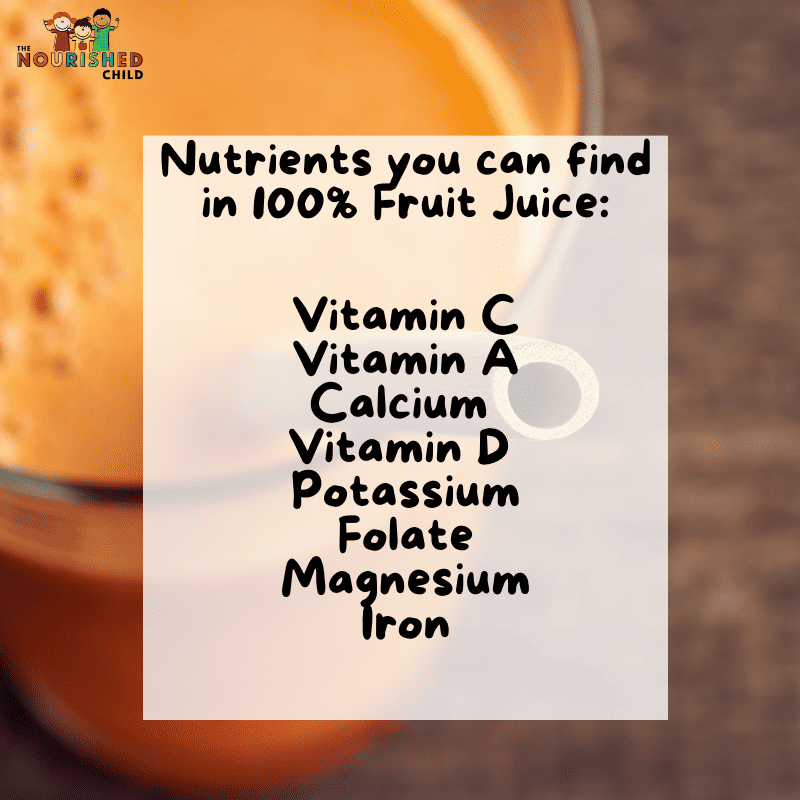
What are the Nutritional Benefits of Fruit Juice?
100% Fruit juice comes packed with a host of nutrients, depending on the type of juice, including:
- Vitamin C
- Vitamin A
- Calcium
- Vitamin D
- Potassium
- Folate
- Magnesium
- Iron
The specific nutrient content of fruit juice varies depending on the type of fruit used. For example, orange juice is a good source of vitamin C, while grape juice is a good source of potassium.
Fruit juice can also contain other beneficial compounds, such as antioxidants and phytonutrients.
Antioxidants help to protect the body from damage caused by free radicals, while phytonutrients are plant compounds that have a variety of health benefits.
Today, some fruit juices are fortified with extra nutrients. Take orange juice, for example. You can purchase it with added calcium and vitamin D.
Juices for Toddlers and Children
Here are some of the most common juices for toddlers and kids with some nutritional highlights:
Orange Juice
Orange juice is a good source of vitamin C, potassium, and folate. If fortified with vitamin D, it can also be a good source of this nutrient, too.
If you are giving your toddler orange juice, be sure to choose 100% orange juice. Avoid orange drinks and orange cocktails, which often contain added sugar and other ingredients.
Apple Juice
Apple juice is a good source of vitamin C and potassium, which are essential nutrients for toddlers.
If you are giving your toddler apple juice, be sure to choose 100% apple juice.
Prune Juice
Prune juice is made from prunes, which are dried plums. It is a good source of fiber and potassium, and it can be helpful for toddlers who are constipated.
An 8-ounce glass of prune juice contains about 2.6 grams of fiber.
Prune juice is a source of sorbitol, a sugar alcohol. Sorbitol can cause diarrhea and abdominal pain in some toddlers. If your toddler experiences these symptoms, stop giving them prune juice and talk with your pediatrician.
Cranberry Juice
Cranberry juice is a good source of vitamin C and antioxidants, and it can be a healthy part of a toddler’s diet. If you are giving your toddler cranberry juice, be sure to choose 100% cranberry juice.
Avoid cranberry drinks and cranberry cocktails, which often contain added sugar and other ingredients.
Cranberry juice is acidic and can irritate the bladder. If your toddler has a history of urinary tract infections (UTIs), talk with your pediatrician before giving them cranberry juice.
Carrot Juice
Carrot juice is a good source of beta-carotene, which is converted to vitamin A in the body.
Vitamin A is important for vision, immune function, and cell growth. Carrot juice is also a good source of other vitamins and minerals, such as vitamin C, potassium, and fiber.
Is Raw Juice Okay for Toddlers?
It is not recommended for toddlers to have raw juice. Raw juice has not been pasteurized, which is a process that kills harmful bacteria.
Toddlers have weaker immune systems and they are at risk of getting sick from harmful bacteria. If you want to give your toddler juice, be sure to choose 100% pasteurized fruit juice.
Related reading: Raw vs Pasteurized Milk
Best Juice for Toddlers
The best juice for toddlers is 100% fruit juice. That doesn’t mean your child can drink as much as they want. Keep to the advised limits and stretch it out by diluting juice with water.
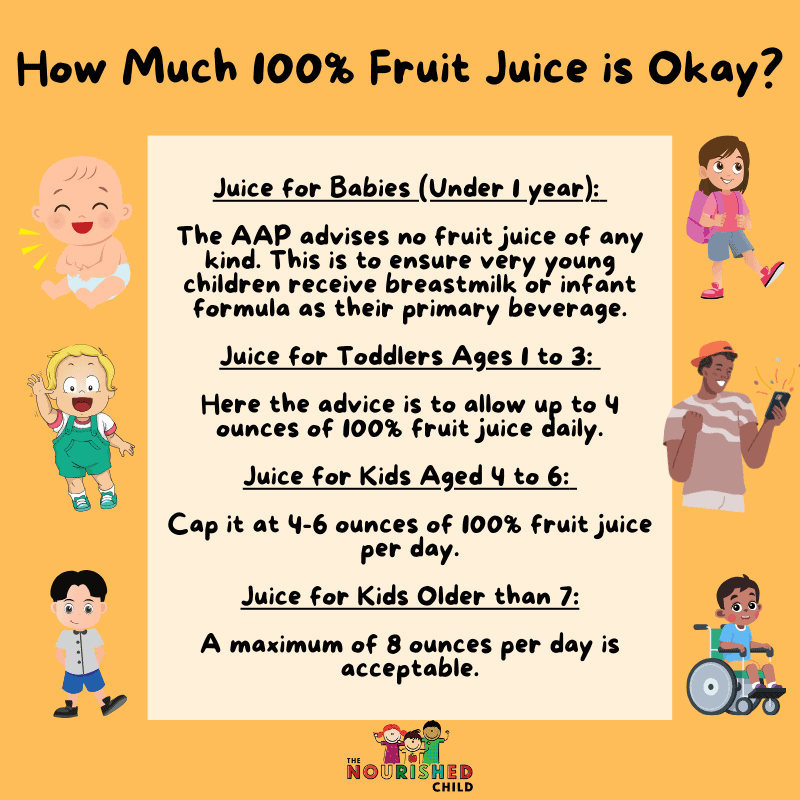
How Much Fruit Juice is Okay for Kids?
The American Academy of Pediatrics (AAP) recommends limiting 100% fruit juice in an effort to prevent overconsumption and underconsumption of needed nutrients. Often, children can drink too much juice and this can contribute to excessive growth or a lack of growth.
Here are the recommendations for juice consumption in children:
Juice for Babies (Under 1 year):
The AAP advises no fruit juice of any kind. This is to ensure very young children receive breastmilk or infant formula as their primary beverage.
Juice for Toddlers Ages 1 to 3:
Here the advice is to allow up to 4 ounces of 100% fruit juice daily.
Juice for Kids Aged 4 to 6:
Cap it at 4-6 ounces of 100% fruit juice per day.
Juice for Kids Older than 7:
A maximum of 8 ounces per day is acceptable.
The Drawbacks of Drinking Juice
Too much of a good thing can be harmful. Excessive juice consumption can lead to:
- Cavities: Sugar coats the teeth, especially if juice is consumed before bed, and increases the risk for cavities.
- Accelerated or Impaired Growth: Juice can be a source of additional calories, beyond what is needed. Drinking too much juice can curb appetite, causing slowed growth.
- Diarrhea and abdominal pain: Too much juice can cause diarrhea and abdominal pain in young children. This is because juice is low in fiber and high in sugar, which can irritate the digestive system.
- Nutrient deficiencies: Juice can displace other, more nutrient-rich foods from a child’s diet. This can lead to nutrient deficiencies, such as a deficiency in iron or vitamin D.
10 Tips for Nutritious Fruit Juice Consumption
To ensure that juice remains a positive part of your child’s eating pattern, consider the following:
- Opt for whole fruit. Choose whole fruit over juice. It offers the same nutrients, plus the fiber that helps your child stay full longer.
- Avoid bedtime juice. Don’t offer juice before bedtime.
- Keep juice in an open-top cup. Juice in bottles or sippy cups increases the risk for cavities.
- Look for pulp. Juice with pulp provides some fiber.
- Check for fortification. Select 100% fruit juice fortified with calcium or vitamin D.
- Monitor juice intake. If your child is experiencing weight or digestive issues, evaluate their juice consumption.
- Offer water or milk instead of juice. Water and milk are good options for children.
- Dilute juice with water. This will reduce the sugar content of the juice.
- Serve juice with a meal or snack. This will help to prevent your child from drinking too much juice at once.
- Be a good role model. Limit your own juice intake and set a good example for your child.
Fruit juice can be a part of a nutritious and enjoyable eating pattern for toddlers and children when consumed in moderation.

Jill Castle, MS, RD
I like empowering parents to help their children and teens thrive at every size with realistic advice centered on healthful habits around food, feeding, nutrition and health behaviors. As a pediatric dietitian and author, my goal is to share strategies and realistic advice to help you raise a healthy and happy child through my articles and podcast.
